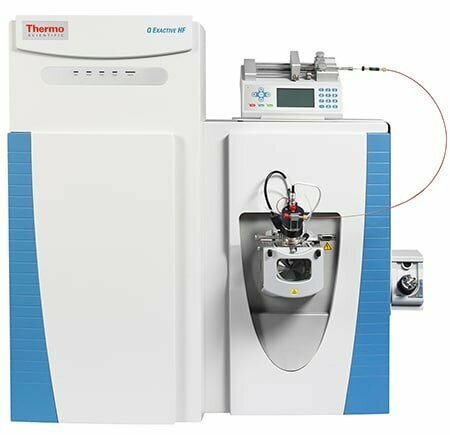Proteomics core facility
The Proteomics Core Facility of University of Tartu (UT PCF) offers a mass spectrometry (MS) based proteomics analysis services. MS proteomics analysis enables to characterize, both qualitatively and quantitatively, the protein and peptide composition of various biological samples (tissues, cells, bodily fluids etc.). We offer our services to the research groups within the university, to other scientific institutions both inside and outside Estonia, and to the biotechnology industry.
Our services include:
• Protein identification and sequencing.
• Label-free or label-based (e.g. SILAC) quantification of proteins.
• Analysis of post-translational modifications of proteins.
For more detailed inquiries regarding our services, please contact the head of the facility Ivar Ilves (ivar.ilves@ut.ee). Please contact us also for discussing the details of your experiment setup before submitting any samples - this would help us to tailor the analysis according to your needs.
The sample submission and transport instructions to the laboratory
Monitor our current sample analysis queue.
INSTRUMENTATION
The following instruments are available at UT PCF.
Electrophoresis
• Agilent 3100 OFFGel
• Invitrogen XCell SureLock MiniCell SDS-PAGE
• Expedeon GELFREE 8100
Liquid chromatography
• Agilent 1200 Series nano-LC
• Dionex Ultimate3000 RSLC nano-LC
• Thermo Fisher Scientific easy-nLC 1000
Mass spectrometers
• Thermo Fisher Scientific Q Exactive Plus
• Thermo Fisher Scientific Q Exactive HF

Ivar Ilves, PhD (molecular virology), head of the facility, e-mail: ivar.ilves@ut.ee
Merilin Saarma, MSc (biology), technician, e-mail: merilin.saarma@ut.ee
Publications
Pochopien, A. A.; Beckert, B.; Kasvandik, S.; Berninghausen, O.; Beckmann, R.; Tenson, T.; Wilson, D. N., Structure of Gcn1 bound to stalled and colliding 80S ribosomes. Proceedings of the National Academy of Sciences 2021, 118, (14).
Crowe-McAuliffe, C.; Takada, H.; Murina, V.; Polte, C.; Kasvandik, S.; Tenson, T.; Ignatova, Z.; Atkinson, G. C.; Wilson, D. N.; Hauryliuk, V., Structural basis for bacterial ribosome-associated quality control by RqcH and RqcP. Molecular Cell 2021, 81, (1), 115-126. e7.
Kasvandik, S.; Saarma, M.; Kaart, T.; Rooda, I.; Velthut-Meikas, A.; Ehrenberg, A.; Gemzell, K.; Lalitkumar, P. G.; Salumets, A.; Peters, M., Uterine fluid proteins for minimally invasive assessment of endometrial receptivity. The Journal of Clinical Endocrinology & Metabolism 2020, 105, (1), 219-230.
Campbell, K.; Westholm, J.; Kasvandik, S.; Di Bartolomeo, F.; Mormino, M.; Nielsen, J., Building blocks are synthesized on demand during the yeast cell cycle. Proceedings of the National Academy of Sciences 2020, 117, (14), 7575-7583.
Mutso, M.; Morro, A. M.; Smedberg, C.; Kasvandik, S.; Aquilimeba, M.; Teppor, M.; Tarve, L.; Lulla, A.; Lulla, V.; Saul, S., Mutation of CD2AP and SH3KBP1 binding motif in alphavirus nsP3 hypervariable domain results in attenuated virus. Viruses 2018, 10, (5), 226.
Ahlstrand, T.; Torittu, A.; Elovaara, H.; Välimaa, H.; Pöllänen, M. T.; Kasvandik, S.; Högbom, M.; Ihalin, R., Interactions between the Aggregatibacter actinomycetemcomitans secretin HofQ and host cytokines indicate a link between natural competence and interleukin-8 uptake. Virulence 2018, 9, (1), 1205-1223.
Lahtvee, P.-J.; Sánchez, B. J.; Smialowska, A.; Kasvandik, S.; Elsemman, I. E.; Gatto, F.; Nielsen, J., Absolute quantification of protein and mRNA abundances demonstrate variability in gene-specific translation efficiency in yeast. Cell systems 2017, 4, (5), 495-504. e5.
Huter, P.; Arenz, S.; Bock, L. V.; Graf, M.; Frister, J. O.; Heuer, A.; Peil, L.; Starosta, A. L.; Wohlgemuth, I.; Peske, F., Structural basis for polyproline-mediated ribosome stalling and rescue by the translation elongation factor EF-P. Molecular cell 2017, 68, (3), 515-527. e6.
Resch, U.; Tsatsaronis, J. A.; Le Rhun, A.; Stübiger, G.; Rohde, M.; Kasvandik, S.; Holzmeister, S.; Tinnefeld, P.; Wai, S. N.; Charpentier, E., A two-component regulatory system impacts extracellular membrane-derived vesicle production in group A Streptococcus. MBio 2016, 7, (6).
Mumm, K.; Ainsaar, K.; Kasvandik, S.; Tenson, T.; Hõrak, R., Responses of Pseudomonas putida to zinc excess determined at the proteome level: Pathways dependent and independent of ColRS. Journal of proteome research 2016, 15, (12), 4349-4368.
Kasvandik, S.; Sillaste, G.; Velthut‐Meikas, A.; Mikelsaar, A. V.; Hallap, T.; Padrik, P.; Tenson, T.; Jaakma, Ü.; Kõks, S.; Salumets, A., Bovine sperm plasma membrane proteomics through biotinylation and subcellular enrichment. Proteomics 2015, 15, (11), 1906-1920.
Kasvandik, S.; Samuel, K. l.; Peters, M.; Eimre, M.; Peet, N. d.; Roost, A. M.; Padrik, L.; Paju, K.; Peil, L.; Salumets, A., Deep quantitative proteomics reveals extensive metabolic reprogramming and cancer-like changes of ectopic endometriotic stromal cells. Journal of proteome research 2015, 15, (2), 572-584.
Starosta, A. L.; Lassak, J.; Peil, L.; Atkinson, G. C.; Virumäe, K.; Tenson, T.; Remme, J.; Jung, K.; Wilson, D. N., Translational stalling at polyproline stretches is modulated by the sequence context upstream of the stall site. Nucleic acids research 2014, 42, (16), 10711-10719.
Arike, L.; Peil, L., Spectral counting label-free proteomics. In Shotgun Proteomics, Springer: 2014; pp 213-222.
Peil, L.; Starosta, A. L.; Lassak, J.; Atkinson, G. C.; Virumäe, K.; Spitzer, M.; Tenson, T.; Jung, K.; Remme, J.; Wilson, D. N., Distinct XPPX sequence motifs induce ribosome stalling, which is rescued by the translation elongation factor EF-P. Proceedings of the National Academy of Sciences 2013, 110, (38), 15265-15270.
Peil, L.; Starosta, A. L.; Virumäe, K.; Atkinson, G. C.; Tenson, T.; Remme, J.; Wilson, D. N., Lys34 of translation elongation factor EF-P is hydroxylated by YfcM. Nature chemical biology 2012, 8, (8), 695-697.
